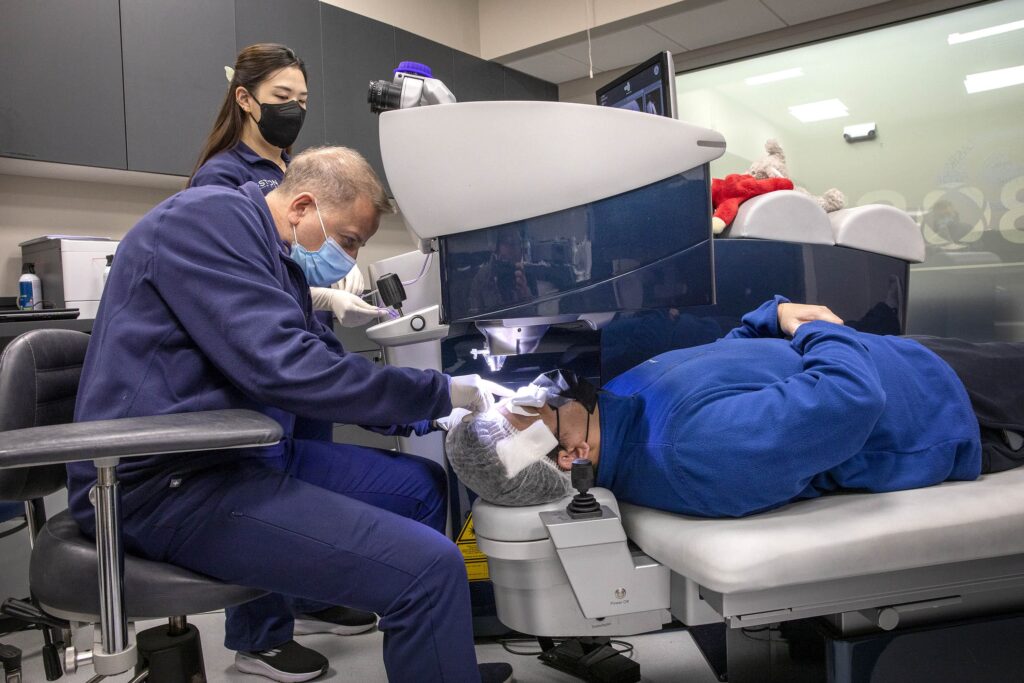Excimer LASIK, often known as laser vision correction, has been widely used for more than two decades. When this procedure is done, the need for glasses or contact lenses is greatly reduced, if not completely removed. To make an educated choice regarding laser eye surgery, you must first understand the fundamentals of the operation, including what to anticipate as well as the benefits, risks, and alternatives.
Candidates who are in excellent health for laser eye surgery
Laser vision correction may help those who are myopic (nearsighted), hyperopic (farsighted), or have astigmatism, which is an imperfection in the cornea, the front surface of the eye.
Certain individuals should avoid having eye surgery lasik. You may be a candidate for this surgery if you satisfy the following criteria:
- You are at least 18 years old.
- It’s been at least a year since your vision hasn’t been compromised, and you’d want to reduce or eliminate the need for contact lenses or glasses in your daily life.
- If you have an ocular or medical contraindication, surgery is not a bad idea.
- Your job, vocation, or passion will not prevent you from getting this procedure.
Before undergoing LASIK, take the following precautions.

You may not be a suitable candidate for LASIK if you have certain medical issues that interfere with recovery. Collagen vascular disorders, lupus, rheumatoid arthritis, and HIV-associated diseases may all affect wound healing, which is critical for a healthy result.
Dry eyes, Sjögren’s illness, uneven astigmatism, a large pupillary size, thin corneas, or corneal keratoconus (a cone-shaped cornea), among other conditions, may make this approach inappropriate.
It’s conceivable that you’ll need glasses after all.
The goal of LASIK is to reduce or remove the need for corrective lenses like glasses or contact lenses. Despite the fact that many individuals are able to function adequately without the use of glasses or contact lenses, certain occupations need optical correction. Furthermore, as previously indicated, laser vision correction has no impact on presbyopia, which is the projected difficulty with close work when one reaches the age of 40 or later. Monovision laser surgeries, in which one eye is corrected for far vision and the other is treated for up-close vision in one session, may help to eliminate presbyopia.
What Is Laser Eye Surgery and How Does It Operate?
The acronym for the most often performed refractive laser surgery is laser eye surgery. An excimer laser is used to vaporize a small portion of corneal tissue after producing a very thin flap in the cornea and folding it back on its own hinge to execute this treatment. After that, the flap is reinstalled in its original location.
Using wavefront guidance, LASIK may be performed.
Like all other technologies, LASIK and other refractive laser operations are always changing and improving. There are now ways for customizing excimer laser corneal tissue removal to each patient’s eyes, resulting in better and more predictable visual results with less visual side effects than previously feasible.
Laser eye surgery includes procedures such as PRK, Epi-LASIK, and LASEK.
Photo-refractive keratectomy (PRK) is a treatment that uses an excimer laser on the cornea instead of a LASIK flap. This approach was created before LASIK and was mostly replaced by LASIK, but it has lately re-emerged as a better choice for individuals with thinner corneas or pre-existing dry eye diseases.

The prescription strength of implantable lenses is quite high.
A tiny number of persons have significant nearsightedness (myopia), to the point where LASIK will not be able to correct their vision without severely damaging the corneal tissue. An prosthetic lens implanted into the front of the iris via a minor incision may be a possibility for people who fall into this group. The Food and Drug Administration (FDA) has approved these plastic lenses for the treatment of severe myopia. This operation is not without risks, including the chance of vision loss.
There are many hazards associated with LASIK.
It’s vital to keep in mind that laser eye surgery is a medical treatment that shouldn’t be taken lightly. As with any surgical surgery, there is a chance that the eye may be damaged, either temporarily or permanently. Blurred or distorted vision, haloes around lights, increased sensitivity to bright lights, glare, dry eyes, and the need to use glasses or contact lenses are all examples of this. It’s also conceivable that you’ll lose your eyesight following PRK or LASIK.
When it comes to choosing an eye surgeon, there are a few things to keep in mind.
Before choosing an ophthalmologist to consult with about LASIK, do some preliminary research. This is a big problem, and you should consider more than simply pricing when making your decision. Personal suggestions, knowledge, and real results are much more important than watching advertising on television or in the media when it comes to eye surgery.
The refractive laser eye surgery treatment takes around 30 minutes. Pre-operative assessment is critical, and it will be performed before to your surgical procedure to ensure that you get the best potential result. The findings of the pre-surgical testing will be used to make the appropriate intraoperative choices during the LASIK. Before the procedure, the eye(s) will be numbed with numerous drops, and you will be laid down on an operating table. Both eyes are often operated on on the same day. You will be given precise instructions after the treatment, including the use of special eye drops to help in the healing process.
Surgical Procedure Preparation
Depending on your ophthalmologist’s advice, you may be able to alleviate dry eye or inflammation using eye drops prior to LASIK. You’ll also be given instructions on when to stop using contact lenses and when to stop applying facial lotions and creams to your face.
Post-Operative Recuperation in the Early Stages
Your ophthalmologist will want to see you within 1 or 2 days after your operation. You’ll be given explicit instructions on when you’re allowed to drive and what activities you’re not allowed to do. You may have little pain or discomfort after surgery, as well as a foreign body feeling in one or both eyes, changes in your vision from hour to hour, periodic visual fog, and eye tears.

